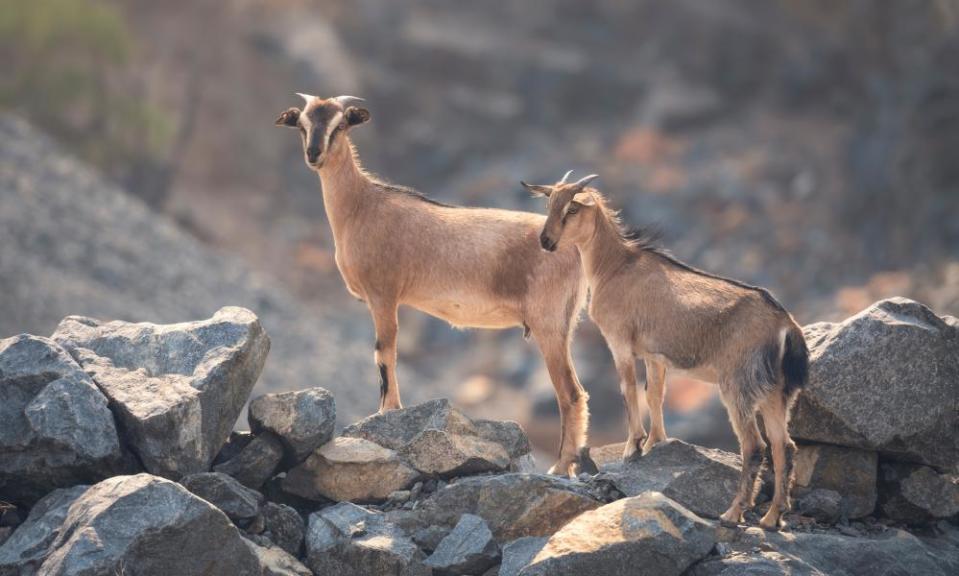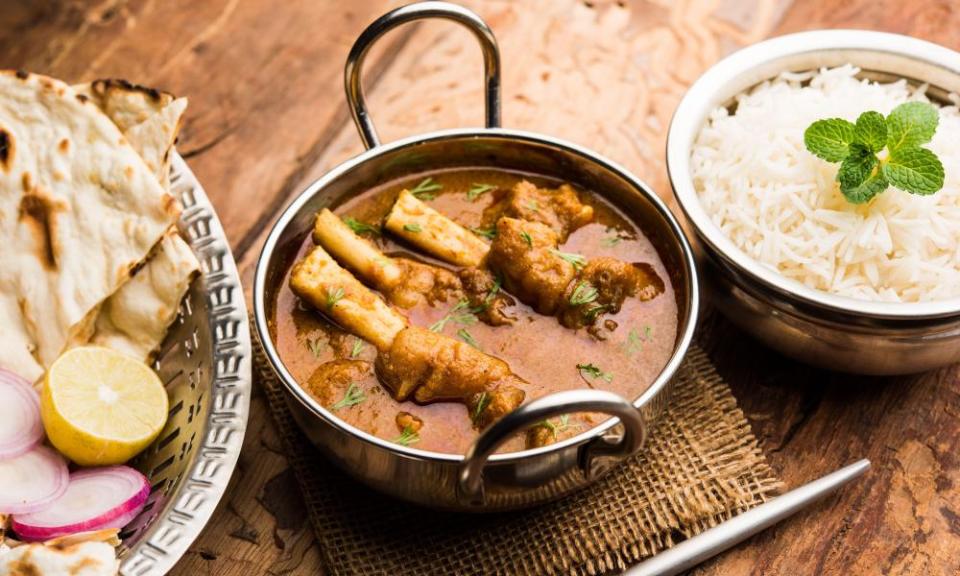Australians eat lots of lamb but we don't fancy goat. Why?

Australia is a nation of sheep eaters. Per capita, only Kazakhstan consumes more, according to OECD meat consumption data. Knowing this it is perhaps less surprising that Meat and Livestock Australia’s eccentric, expensive lamb advertisements have become an annual media event.
So why doesn’t the other commonly eaten member of the Caprinae sub family, the goat, get a look-in? Australians consume goat milk and goat cheese, but goat meat is still considered a niche product.
Food historian Jacqui Newling says British settlers brought livestock (cows, sheep, pigs) so they could have fresh meat instead of the preserved meat they ate on the journey. And sheep were important as a source of wool. To raise these livestock, colonists opened pastures based on their Anglo-Celtic experience – at great cost to traditional owners and the environment.
Related: The magic of marinading: 'It requires forethought, but the results are truly worth the effort'
In comparison, goats do not need the same type of pasture and can survive on marginal land. “Goats are hardier,” Newling says. “They are foragers and can survive on arid land. But this also meant they have a higher chance of becoming wild or feral if farmers did not fence them in properly.”
Some goats did arrive in Australia with the first fleet in 1788, but some escaped and adapted into the Australian rangeland goat. Now there are an estimated 2.6m feral goats in Australia which are considered an agricultural and environmental pest but are also valued for their meat. This could be why some consumers dismiss goats as ‘‘wilder” animals, less suitable for eating than domesticated cows or sheep.

The meat industry has made some effort to rebrand goat, calling it “free roaming rangeland” rather than “feral”. These semi-wild rangeland goats make up most of Australian’s goat production. Their control and harvesting also depends on market forces. When the price of goat is high, farmers muster the rangeland goats and sell to abattoirs, which is also a form of pest control.
Irrespective of the branding, goat stew is the second most popular dish in Sydney’s Nigerian restaurant Little Lagos – after jollof. This could be because owner Ade Adeniyi encourages people to try goat stew: “I tell them, if you don’t like it, you don’t have to pay. But when they try it, they enjoy it.”
Goat meat and beef are the standard red meat options in Nigeria, depending on the region. Adeniyi believes one of the reasons Australians hesitate to try goat meat is because they are not used to it: “Raw goat has a stronger smell. But when you sear it and add it to a stew of tomatoes, habanero chilli and capsicum, the smell reduces. After that, it is no different from lamb or beef.”
The bony and gamey meat means goat is best suited for curries and stews, which is why it works well as a staple in south Asian, Middle Eastern and African cuisines where meat is often slow cooked in a gravy until it falls off the bone. “To cook this goat stew in Little Lagos we need meat with bones on it because it’s the bones and marrow that gives it the flavour,” Adeniyi sayss. Goat is not a meat that can be thrown on the barbecue to grill for six to 10 minutes, unlike lamb, which is fattier and more tender.
Adeniyi believes the difference in cut requires a mental shift for some customers: “People feel like they get their money’s worth from eating the goat flesh. If there’s more bones than flesh they feel a bit cheated. They are not used to chewing the bone or around the bone to extract the flavour.”
Mesopotamian chef and founder of Refugee Voices, Ahmad Hakim, echoes this in his observation of modern-day Australian eating habits: “Compared to Iranian or Arabic culture, Australians prefer convenience in their cooking and eating, which is why fish fillet or chicken breast are popular. Cooking goat meat is not for every day; it requires time and effort.”
Related: Parts unknown: whole animal recipes from Feather and Bone
Despite the popularity of goat stew in Little Lagos, it’s availability in the restaurant can be erratic. Goat production is minute compared with that of lamb and beef. In 2019 goat production totalled 22,381 tonnes carcase weight while lamb was 503,146 tonnes carcase weight. From that, only 10% of Australia’s goat meat production is used domestically – the rest is exported to places like the US and Taiwan – making Australia one of the world’s largest exporters of goat meat. Goat meat is also more expensive than other meats because of the limited domestic supply. Goat prices started increasing since May 2019 and have surpassed lamb.
The tide could be turning though. Mark Presland owns a butcher shop in inner Melbourne and finds an increasing demand for goat meat among home cooks: “We have a diverse range of customers who are just trying to experiment with food. They look up recipes and want to cook different things, especially curries. I think this is where the demand for goat is picking up. It’s still unlikely to take over lamb or beef; we sell four times more lamb than goat.”
Presland has learned to cut goat meat for curries: “There must be bones on the flesh. That’s the key.”

Arabian goat curry
by Ahmad Hakim, chef and founder of Refugee Voices
This recipe is based on Hakim’s Mesopotamian background. The goat can be replaced with lamb.
2 large onions, diced
4 cloves of garlic, minced
1 teaspoon minced/grated ginger
1 kilogram goat meat, cut into small pieces
2 cinnamon sticks
1 teaspoon curry powder
1 teaspoon mild paprika
1 teaspoon dried crushed chilli
3 whole cloves
1 whole star anise
1 cup mint leaves, finely chopped
1 cup of coriander leaves, finely chopped
2 tablespoons tomato paste
2 tomatoes, cut into quarters
1 cup of plain yoghurt
1 teaspoon salt
1 litre (approx.) water
In a large saucepan, saute onion, garlic and ginger until golden. Add the meat and fry for about one minute to get some colour on it. Next add the spices, and fry off until they’re fragrant. Add the fresh fresh herbs and stir through, then add the tomato paste and fresh tomato, stirring for a minute. Pour in the yoghurt and salt, combine, then add the water and bring to the boil.
Once boiling, reduce the heat and simmer rapidly with the lid on for about an hour or until the goat is tender and the sauce has thickened.
Serve with rice or bread.

 Yahoo Finance
Yahoo Finance 